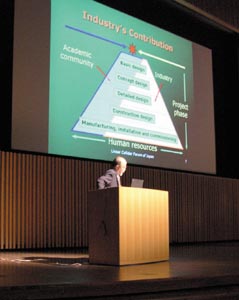The Asian Committee for Future Accelerators (ACFA), together with the Japan Association of High Energy Physics (JAHEP) and the High Energy Accelerator Research Organization (KEK), have published a “roadmap report” for their linear collider project. The report was made public at the ACFA Linear Collider Symposium, held on 12 February at the international congress centre of Tsukuba in Japan. Nearly 400 people attended, not only from laboratories and universities around the world, but also from industry.

The linear collider project is an important one for ACFA. In statements in 1997 and 2001 ACFA strongly recommended that a linear collider should be constructed in the Asia-Pacific region with Japan as host for the worldwide international project, which should be operated concurrently with the Large Hadron Collider at CERN. The objective of the symposium was to explore the scope of the ACFA Linear Collider Project, including the overall design, cost, site and organizational aspects. The programme also included presentations on the viewpoints from the US, Europe and various ACFA countries, as well as from industry.
The initial goal of the ACFA linear collider is to perform experiments at a centre-of-mass energy (Ecm) of up to 500 GeV, with a luminosity of more than 1034 cm-2s-1. The design, as presented by Kaoru Yokoya of KEK, is based on a pair of linear accelerators installed in a straight tunnel about 30 km long. The main linacs will use X-band (11.424 GHz) RF technology, which has been developed in close collaboration with the NLC group in the US. This allows the electrons and positrons to be accelerated at 50 MeV/m or faster.
An important feature of the project is its energy-upgradability. The tunnel will be long enough for a machine eventually to reach Ecm = 1 TeV, but initially it would be only half-filled with RF accelerating structures. The energy could also reach beyond 1 TeV using the same technology – for instance, 1.25 TeV with one-third of the full luminosity.
Another option would use C-band (5.712 GHz) RF technology from about 400 GeV, with X-band accelerating structures filling the remaining space in the tunnel at a future upgrade.
A working group formed in 2001 listed eight candidate sites in Japan with the appropriate geology; an additional four sites are of interest because they are already national bases of scientific R&D. Atsushi Enomoto presented these options together with a description of the facility, including the underground tunnel structure, civil engineering processes, and systems for electric power and cooling. To maintain the accelerator complex continuously, the design foresees a double-tunnel structure – one for klystrons etc and the other running in parallel for accelerating structure.
Hirotaka Sugawara, KEK’s director-general until the end of March, revealed that the total construction cost of the linear collider is estimated to be ¥495.1 billion (€3.86 billion) for the baseline case, in which the main linacs to support operation at Ecm = 500 GeV are built within tunnels that can eventually support operation at Ecm = 1 TeV. The cost also includes payment of all human resources other than accelerator scientists.
ACFA recommended in their statements that the linear collider should be built as an international facility open to all interested parties. Based on this recommendation, a committee formed in July 2001 has recently issued a report describing how the linear collider might be organized as a truly global project. As Sakue Yamada of KEK explained, the proposal is for a new international laboratory, the Global Linear Collider Centre (GLCC), to be created in Japan to facilitate the long-term commitment of participating partners, as well as open and transparent management. All partners would be on an equal footing although the contributions in financial and/or human resources may vary widely. In order to realize the GLCC quickly, the formation of a Pre-GLCC was proposed. A worldwide team would work together, irrespective of their preferences concerning the host, site or accelerator technology.
N Ozaki, the secretary-general of the Linear Collider Forum of Japan – a collaboration between the academic side and industrial companies formed in 2002 – discussed the linear collider from the industry point of view. Industry has a strong interest in the linear collider because its research may lead to business innovation.
Ozaki clearly described the importance of co-operation between researchers and industry from the beginning of the project. He emphasized that industry wants an early start for the linear collider project, and stressed that Japanese industry hopes to have industrial partners in other countries. The forum has plans to visit them in order to build up international collaboration.
In concluding remarks, Sachio Komamiya from the University of Tokyo and the chairman of JAHEP spelt out the steps needed to realize the project. He emphasized that the final engineering design should be carried out by a global team under the Pre-GLCC, and should be completed by 2007. The construction of the machine is expected to take five years, including the excavation of tunnels and the installation of the accelerator, so commissioning could start in 2012.








